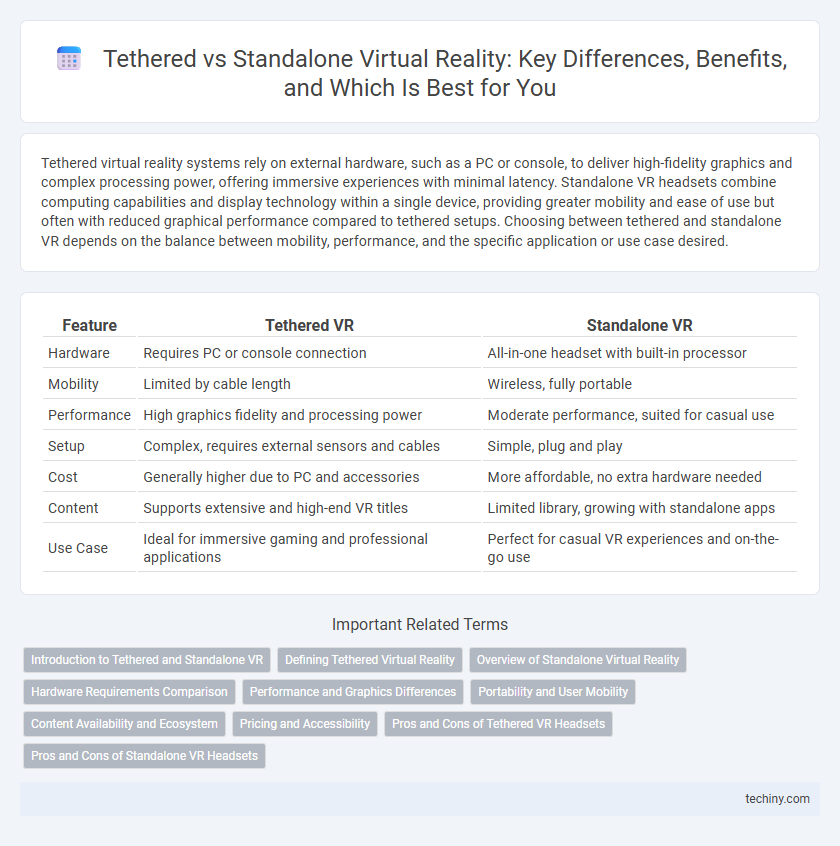Tethered virtual reality systems rely on external hardware, such as a PC or console, to deliver high-fidelity graphics and complex processing power, offering immersive experiences with minimal latency. Standalone VR headsets combine computing capabilities and display technology within a single device, providing greater mobility and ease of use but often with reduced graphical performance compared to tethered setups. Choosing between tethered and standalone VR depends on the balance between mobility, performance, and the specific application or use case desired.
Table of Comparison
| Feature | Tethered VR | Standalone VR |
|---|---|---|
| Hardware | Requires PC or console connection | All-in-one headset with built-in processor |
| Mobility | Limited by cable length | Wireless, fully portable |
| Performance | High graphics fidelity and processing power | Moderate performance, suited for casual use |
| Setup | Complex, requires external sensors and cables | Simple, plug and play |
| Cost | Generally higher due to PC and accessories | More affordable, no extra hardware needed |
| Content | Supports extensive and high-end VR titles | Limited library, growing with standalone apps |
| Use Case | Ideal for immersive gaming and professional applications | Perfect for casual VR experiences and on-the-go use |
Introduction to Tethered and Standalone VR
Tethered VR headsets rely on a physical connection to a powerful PC or gaming console, delivering high-quality graphics and low latency for immersive experiences. Standalone VR devices contain built-in processors and storage, offering wireless freedom and portability without sacrificing decent performance. Each type caters to different user needs, with tethered systems favored by enthusiasts seeking cutting-edge visuals and standalone units appealing to casual users prioritizing convenience.
Defining Tethered Virtual Reality
Tethered virtual reality refers to VR systems connected to a powerful external device, such as a gaming PC or console, via cables to deliver high-fidelity graphics and complex processing capabilities. These headsets, like the Oculus Rift S or HTC Vive Pro, rely on wired connections to ensure low latency and precise tracking essential for immersive experiences. The dependency on external hardware limits mobility but enhances performance, making tethered VR ideal for high-end simulations and detailed virtual environments.
Overview of Standalone Virtual Reality
Standalone virtual reality headsets offer an all-in-one solution by integrating processing power, display, and sensors within a single device, eliminating the need for external hardware or PC connections. These headsets, such as the Oculus Quest series, provide greater mobility and ease of use, enabling immersive VR experiences without tethered cables. Standalone VR systems support a wide range of applications, from gaming to training simulations, leveraging built-in tracking and controller technologies for seamless interaction.
Hardware Requirements Comparison
Tethered VR headsets require a powerful PC or console with high-end GPUs like NVIDIA RTX 3080 or AMD RX 6800 XT to deliver immersive experiences, demanding substantial processing power and connectivity through cables. Standalone VR headsets feature built-in processors such as Qualcomm Snapdragon XR2, integrated graphics, and onboard storage, reducing dependency on external hardware but offering slightly lower graphical fidelity. The hardware trade-off centers on portability and ease of use for standalone systems versus the superior performance and visual quality enabled by tethered setups.
Performance and Graphics Differences
Tethered VR headsets deliver superior performance and graphics quality by leveraging the processing power of high-end gaming PCs, enabling higher frame rates, richer textures, and more complex environments. Standalone VR headsets rely on built-in processors, which limits graphical fidelity and performance but offers greater mobility and ease of use without external cables. The key difference lies in the hardware capabilities, where tethered systems excel in immersive visuals, while standalone devices prioritize convenience and accessibility.
Portability and User Mobility
Tethered VR headsets rely on wired connections to powerful PCs or consoles, limiting user mobility and confining experiences to fixed play areas. Standalone VR devices integrate processing hardware and batteries, offering enhanced portability and freedom of movement without tether restrictions. This increased mobility supports immersive interactions in diverse environments, making standalone VR ideal for on-the-go applications and spatial exploration.
Content Availability and Ecosystem
Tethered VR headsets provide access to a vast ecosystem of content through PC or console connections, enabling high-fidelity, graphically intensive experiences. Standalone VR devices offer greater portability and ease of use, drawing from a growing library of optimized titles within a self-contained platform. Content availability in tethered systems is broader due to compatibility with established marketplaces and development tools, while standalone ecosystems continuously expand but often feature more specialized or mobile-oriented experiences.
Pricing and Accessibility
Tethered VR headsets typically cost less upfront but require a powerful gaming PC or console, increasing the total investment and limiting accessibility. Standalone VR devices offer all-in-one functionality with built-in processing, providing greater convenience and portability at a higher initial price. Accessibility improves with standalone models due to fewer hardware dependencies, making VR experiences more readily available to casual users and beginners.
Pros and Cons of Tethered VR Headsets
Tethered VR headsets offer superior graphics and processing power by connecting directly to a PC, enabling high-fidelity experiences ideal for gaming and professional applications. However, their reliance on cables limits mobility and can cause discomfort during prolonged use, restricting natural movement. The need for a powerful external device increases overall system cost and setup complexity compared to standalone VR systems.
Pros and Cons of Standalone VR Headsets
Standalone VR headsets offer enhanced portability and convenience by eliminating the need for external devices or cables, allowing users to experience virtual environments anywhere. However, their limited processing power and battery life can reduce performance and session duration compared to tethered headsets that rely on powerful PCs or consoles. These devices often feature integrated sensors and displays optimized for all-in-one use, but they may lack the high-end graphics and tracking precision available with tethered systems.
Tethered vs Standalone Infographic

 techiny.com
techiny.com